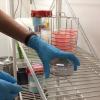Antibiotics are medications used to treat infections caused by bacteria. Bacteria can become insensitive (resistant) to antibiotics. If this occurs, the antibiotics cannot kill or inhibit the bacteria. The antibiotics then no longer work. This is called antimicrobial resistance or antibiotic resistance.
Antibiotic resistance or antimicrobial resistance
In addition to bacteria, other micro-organisms do not always respond well to treatment with medicines either. Antimicrobial resistance (AMR) is therefore a growing concern.
Read more: What is resistance?
Resistant micro-organisms
More and more bacteria are becoming resistant to commonly used antibiotics. These antibiotics are also referred to as first-choice or first-line antibiotics. Bacteria that are resistant to commonly used antibiotics or to multiple classes of antibiotics are referred to as highly resistant micro-organisms (HRMOs).
Would you like to know more about resistant micro-organisms? Contact amr@rivm.nl.
Policy and guidelines
At the national level, there are all sorts of rules and policies in place for addressing antimicrobial resistance. In addition, there are guidelines for helping healthcare professionals prevent and fight antimicrobial resistance in care facilities and beyond.
Would you like to know more about policy and guidelines? Contact amr@rivm.nl
Surveillance
AMR surveillance involves monitoring the occurrence of resistant micro-organisms in the Netherlands and the characteristics of those micro-organisms and of the patients that have them.
Read more about AMR surveillance.
Partnerships
To reduce antimicrobial resistance, the Netherlands has adopted the One Health approach: a joint approach to resistance in humans, animals and the environment. To that end, RIVM collaborates with many different regional, national and international authorities, care facilities and organisations.
Read more about Collaboration on antimicrobial resistance
Publications
RIVM publishes a wide range of articles and reports on antimicrobial resistance.









